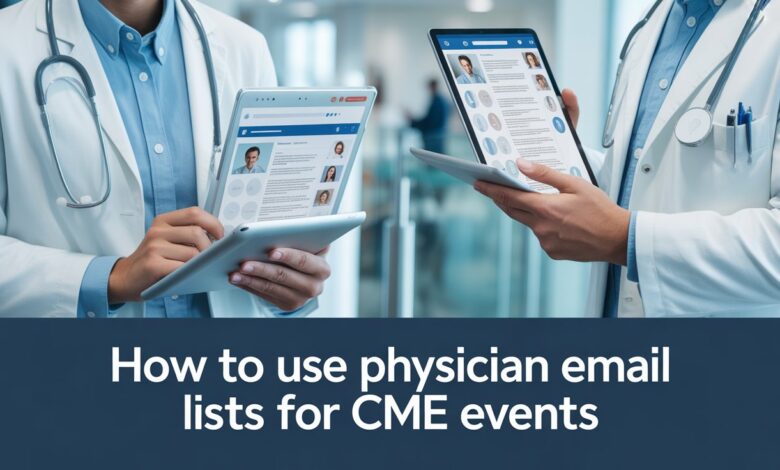How to Use Physician Email Lists for Event Invitations and CME Promotions

In the evolving world of healthcare marketing, engaging busy physicians requires precision, timing, and trust. Traditional outreach—through print, calls, or reps—often fails to deliver measurable impact. That’s why digital channels have become indispensable for medical communication, especially when it comes to event invitations and CME (Continuing Medical Education) promotions.
Among all available digital strategies, a Physician Email List stands out as the most direct, measurable, and compliant tool for reaching medical professionals with event-related communication. When managed and executed correctly, it can boost registrations, enhance engagement, and help establish your organization as a trusted source of medical education.
1. The Strategic Role of Physician Email Lists in Event and CME Marketing
Physicians receive hundreds of marketing messages daily. To capture their attention, your outreach needs to be highly targeted, credible, and valuable. A physician email database allows marketers to reach specific doctors by:
- Specialty: Cardiologists, oncologists, dermatologists, etc.
- Location: Local, regional, or international physicians.
- Seniority: Residents, practitioners, heads of departments, or medical directors.
- Institution Type: Hospitals, clinics, academic centers, or private practices.
When you align your event messaging with the recipient’s specialty or educational need, your email no longer feels like spam — it becomes an invitation to learn, collaborate, and grow professionally.
This precision targeting is especially useful for CME programs, where physicians are actively looking to update their knowledge and earn credits from credible institutions.
2. How to Segment and Personalize Your Outreach
Segmentation transforms a raw database into a relationship-building asset. Before sending invitations, categorize your audience into meaningful clusters such as:
| Segmentation Criteria | Purpose | Example Application |
| Medical Specialty | Ensures topic relevance | Invite neurologists to a neuroscience CME workshop |
| Geography | Targets regional attendees | Send local invites for in-person events |
| Past Attendance | Improves loyalty | Offer early access to previous attendees |
| Engagement History | Refines messaging | Send reminders only to those who opened prior emails |
| Practice Type | Adjusts communication tone | Differentiate between academic and private practitioners |
Segmentation doesn’t just improve open rates — it creates a sense of personalization that shows respect for the physician’s time and interests.
3. Crafting High-Impact Event Invitations
A successful email invitation balances clarity, brevity, and authority. Physicians don’t have time for vague or flashy marketing — they value concise communication and tangible benefits.
Here’s what makes an effective event invitation email:
a. Strong, Professional Subject Line
Your subject line determines whether your email gets opened. Examples include:
- “Join Our CME-Accredited Webinar on Precision Oncology – Limited Seats”
- “Invitation: National Cardiology Innovation Summit 2025”
Avoid overpromising or using gimmicks — physicians appreciate straightforward professionalism.
b. Clear Event Details
Always highlight the essentials upfront: event name, date, time, format (in-person/webinar), and CME credits offered.
c. Educational Value and Speaker Credibility
Mention faculty names, affiliations, and credentials. Physicians are more likely to engage when the event features recognized experts or institutions.
d. Visual Structure and CTA
Use a clean, scannable layout with a visible call-to-action (e.g., “Register Now” or “Confirm Your Attendance”). Keep the design mobile-friendly since many physicians check emails on smartphones.
See also: What Is a Smart Ring Used For? A New Era in Holistic Health Tracking
4. Developing an Email Sequence for Maximum Impact
One email is rarely enough. A multi-step campaign ensures higher visibility and engagement across different stages of your outreach.
| Email Type | Timing | Objective | Content Focus | CTA Example |
| Save the Date | 4–6 weeks before event | Early awareness | Introduce theme, speakers, and CME benefits | Add to Calendar |
| Detailed Invitation | 3–4 weeks before | Main outreach | Full agenda, learning objectives, registration details | Register Now |
| Reminder Email | 1 week before | Final nudge | Highlight last chance to register | Secure Your Spot |
| Follow-Up / Thank You | After event | Engagement retention | Share materials, thank participants, invite to next event | Access Recordings |
This systematic approach keeps your event top-of-mind without overwhelming your audience.
5. Best Practices for CME Promotions via Email
CME programs demand credibility, accuracy, and trustworthiness. Since these events directly influence physician learning and licensure, the messaging must emphasize professionalism over promotion.
Key tactics for successful CME campaigns include:
- Highlight Accreditation: Clearly state the accrediting body (e.g., AMA PRA Category 1 Credits™).
- Show Learning Outcomes: Physicians want to know what practical skills or knowledge they’ll gain.
- Include Faculty Profiles: Demonstrate authority and expertise to reinforce value.
- Automate Reminders: Use automation tools to send reminders for registration deadlines or course availability.
- Provide Post-Event Resources: Share slide decks, recorded sessions, and certificates promptly.
An authentic, informative tone ensures your outreach feels educational rather than commercial.
6. Compliance and Ethical Considerations
Working with healthcare data demands strict adherence to compliance frameworks such as:
- HIPAA (U.S.) – Protects medical and personal data privacy.
- GDPR (Europe) – Regulates email consent and data transparency.
- CAN-SPAM Act – Ensures ethical email communication and opt-out options.
When sourcing your database, choose a provider that offers verified, permission-based data and follows rigorous validation processes (e.g., double opt-in verification). Maintaining compliance not only avoids legal risks but also builds brand credibility among physicians.
7. Measuring Performance and Continuous Optimization
Analytics play a critical role in refining your strategy. Evaluate the performance of each campaign using metrics such as:
- Open Rate: Indicates the relevance of your subject lines.
- Click-Through Rate (CTR): Measures interest in the content.
- Conversion Rate: Tracks how many recipients registered or attended.
- Bounce Rate: Identifies outdated or invalid emails.
- Unsubscribe Rate: Helps maintain healthy list hygiene.
Use this data to optimize future campaigns — test different subject lines, CTAs, or send times to identify what resonates best with your audience.
8. Integrating Email with Multichannel Marketing
For maximum visibility, integrate your email campaigns with complementary channels such as:
- Social Media: Promote CME events on LinkedIn or Twitter for credibility.
- Landing Pages: Use dedicated registration pages for better tracking.
- Retargeting Ads: Re-engage physicians who opened emails but didn’t register.
- CRM Systems: Sync event data for personalized post-event communication.
This integrated approach turns your Physician Email List into part of a broader engagement ecosystem that nurtures long-term professional relationships.
Conclusion
Effectively using email marketing for event invitations and CME promotions isn’t about volume — it’s about relevance, timing, and trust. A high-quality physician database enables healthcare organizations to reach the right professionals with the right message, driving both educational impact and brand visibility.
When leveraged strategically, a Physician Mailing List helps organizations go beyond one-time event promotion — it becomes a continuous channel for fostering education, collaboration, and thought leadership within the medical community.




